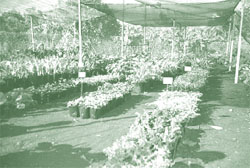Going to town with agriculture
 for the past two decades, urban agriculture has been on the rise throughout the world, in both poor and wealthy nations. Millions of urban residents in Africa, Asia, Latin America, and increasingly in North America, are growing crops and raising livestock in yards, on rooftops and balconies, along roadsides, and on vacant urban land. Until recently, many countries had a strong government perception that agriculture is unsuitable for urban areas. Many district level governments, across the world, are concerned about the growing competition for land and water and incompatible land use. They try to discourage food production in urban areas in the belief that, in addition to competing for scarce valuable land, it contributes to problems of public health. Raising animals is especially discouraged. In stark contrast, the Cuban government has actively supported urban food production, especially in the capital, Havana.
for the past two decades, urban agriculture has been on the rise throughout the world, in both poor and wealthy nations. Millions of urban residents in Africa, Asia, Latin America, and increasingly in North America, are growing crops and raising livestock in yards, on rooftops and balconies, along roadsides, and on vacant urban land. Until recently, many countries had a strong government perception that agriculture is unsuitable for urban areas. Many district level governments, across the world, are concerned about the growing competition for land and water and incompatible land use. They try to discourage food production in urban areas in the belief that, in addition to competing for scarce valuable land, it contributes to problems of public health. Raising animals is especially discouraged. In stark contrast, the Cuban government has actively supported urban food production, especially in the capital, Havana.
Cuba is the only country in the world that has developed an extensive state-supported infrastructure to assist urban food production. This infrastructure emerged in response to acute food shortage in the early 1990s. Its growth also got ideological support from the Cuban government's view that access to nutritious food is a basic human right.
Following the Cuban Revolution in 1959, the new Cuban government made elimination of food scarcity through an elaborate national food distribution system a priority. This system functioned well to distribute food to the Cubans but, it was highly dependent upon food imports; 57 per cent of total food consumed in Cuba was imported from the erstwhile Soviet Union.
With the Soviet Union falling apart in 1989 all food imports were lost leading to immediate food shortages in Cuba. It also lost its source of critical agricultural imports like fertilisers, pesticides, tractors, its spare parts and petroleum on which depended its national food production system. Lack of petroleum brought the food distribution system to a halt; severe fuel shortages meant that food could not be refrigerated or transported by trucks from the suburbs and rural areas. The us made the situation more difficult with the passage of the infamous Toricelli Bill in 1992. The bill banned trade between Cuba and foreign subsidiaries of us- based companies and threatened to confiscate ships that touched the ports of both Cuba and usa within six months. Since food material made up for most of this trade, the Toricelli Bill worsened the situation considerably.
By the end of 1992, food shortage had turned into a crisis throughout Cuba, including Havana, home to 2.2 million Cubans and the largest city in the Caribbean. Like many large cities, Havana was completely dependent upon food imports brought in from the Cuban countryside and abroad. Havana had no food production capability or infrastructure and almost no land for farming.
Worsening food shortages motivated citizens to plant food crops in the yards, patios, balconies, rooftops and vacant land sites near their homes. In some cases, neighbours got together to plants crops
Related Content
- South Africa's Cape Town faces severe economic troubles over drought: Moody's
- Bangladesh State of Environment Report: The Monthly Overview, November, 2014
- Nepal State of Environment Report: The Monthly Overview, November, 2014
- Bangladesh State of Environment Report: The Monthly Overview, April 2014
- Monthly Overview on State of Environment, Nepal, January 2014
- Monthly Overview on State of Environment, Bangladesh, January 2014
